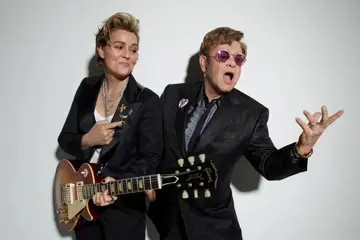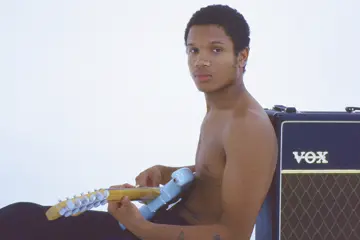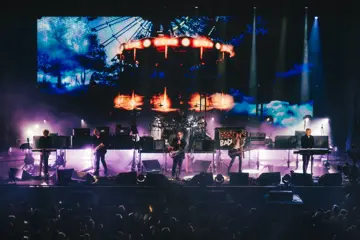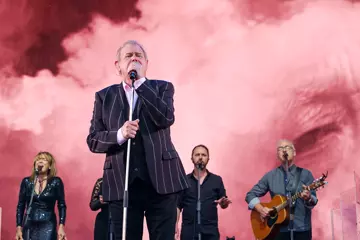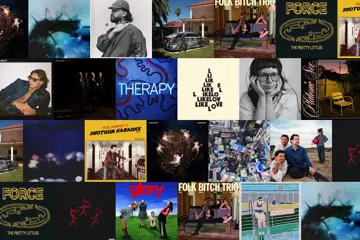 The Presets
The PresetsIf things had gone to plan for The Presets, their debut album, Beams, would’ve sounded very different.
Julian Hamilton and Kim Moyes always wanted to incorporate vocals into their music, and Hamilton would sing during rehearsals to solidify their ideas. But he never imagined he’d be the band’s frontperson.
“When we first started this band, we were going to be like Basement Jaxx or Chemical Brothers and just get guest singers in,” Hamilton told me last year.
Modular Recordings founder Steve “Pav” Pavlovic had other ideas. “At one point, Pav just said, ‘Why don’t you just sing these songs?’” Hamilton recalled. “We hadn’t really considered that I would be a singer in the band. So, I kind of fell into it by accident.”
Pavlovic signed The Presets to Modular after hearing their first demo, which was recorded in Moyes’ kitchen. The demo was converted into The Presets’ debut EP, Blow Up, which came out in November 2003.
Don't miss a beat with our FREE daily newsletter
Hamilton’s lead vocals – albeit breathy and often buried in the mix – feature throughout the EP, including on the electroclash lead single, Beat On / Beat Off, which gained triple j support.
Hamilton went through some growing pains as he adjusted to his role as the lead singer in Sydney’s coolest new dance punk duo. “It took me a good year to learn how to do it on stage,” he said. But he sounded more confident on the band’s second EP, Girl And The Sea, released 12 months after its predecessor.
By the time Beams came out in September 2005, Hamilton had developed a curled-lip yelp-singing style that practically demanded crowd members sing-along. 20 years after the album’s release, Hamilton’s voice and the band he leads are woven into Australia’s pop cultural fabric.
The legacy of Beams was never assured. In a scathing 3.7 review for Pitchfork, journalist Marc Hogan took issue with The Presets’ apparent lack of sophistication. "By far the most frustrating thing about Beams is that Moyes and Hamilton both know better," Hogan wrote. "Geez, they even studied at the Sydney Conservatorium of Music. Until they dropped out to pursue a career in fashion."
The album has aged better than the review – dance music has a long history of slap-it-together production and unintelligible lyricism. It’s not irony in place of substance, but a clear understanding of the objective: to make people move.
That said, The Presets never fully belonged in the electronic dance category. Not only did they have a lead singer, and write songs with verses, choruses, and the occasional middle eight, but they were driven by an experimental, why-the-heck-not creative ethos, which had more to do with post-punk than the synthpop acts they were frequently compared to.
“A reviewer in the UK said [Beams] was the best thing since Depeche Mode’s Violator,” Moyes told Red Bull a few years ago. “We were scratching our heads because we never really listened to Depeche Mode.”
The pair’s influences were a bit more highbrow. Indeed, Hamilton and Moyes met at the Sydney Conservatorium of Music in 1995.
At the time, Moyes was playing vibraphone in the experimental jazz fusion ensemble PROP, alongside Jeremy Barnett on marimba, David Symes on bass and Jared Underwood on drums. After unearthing a Roland Juno-106 synthesizer from under the bed at his dad’s house, Hamilton also joined the band.
PROP gigged around Sydney for a handful of years, supporting the likes of Tortoise and Sonic Youth, and released their debut album, Small Craft Rough Sea, in 2001. The album found a fan in Radio National’s resident music nerd, Brent Clough, who praised the group’s fusion of “jazz, classical, minimalist, funk and techno elements.”
The seeds of The Presets were planted in the PROP rehearsal room. After the rest of the band went home, Moyes would get behind the drum kit and Hamilton would extract silly, chaotic sounds from the Juno. “We’d just play really dumb stuff,” Moyes told Red Bull.
In the early days, The Presets were often compared to their Modular labelmates, Cut Copy. You can understand why: both acts made dance music but performed live with the energy of rock bands.
But in contrast to the slick indietronica of Cut Copy’s debut album Bright Like Neon Love, The Presets’ early work was all over the place – and that was part of its charm.
Beams’ best-known song, Are You The One?, was tailor-made to create a frenzy among boozed-up millennials in the Big Day Out’s Boiler Room.
It revolves around a hulking three-note synth riff, with Hamilton’s vocal melody mirroring the progression. Moyes’ drumming in the pre-chorus is more prog-rock than prog-house, matching the hysteria of Hamilton’s acidic synths with his tumbling tom tom fills. It only takes one listen to memorise the lyrics.
Are You The One? contributed to The Presets’ reputation as pub rock for the new rave crowd. And Hamilton had played plenty of big rock shows in the years preceding Beams. He joined Silverchair in 2001 as a touring keyboard player, working with Paul Mac to recreate the baroque orchestration of Neon Ballroom and Diorama. Hamilton and Moyes were also touring members of Daniel Johns and Mac’s quirky pop band, The Dissociatives.
But despite his competence as a rock keyboardist for hire, Hamilton’s tastes lay elsewhere. “To be honest, I was never really into rock music,” he told me. “I really liked kind of otherworldly music that sounded like it was made by machines.”
As a kid, Hamilton got excited by the techno-pop futurism of Kraftwerk. He later discovered political hip hop crew Public Enemy and UK rave crossover acts The Prodigy and The Chemical Brothers. His first encounter with Aphex Twin is seared into his memory.
“I can’t think of anything that’s really excited me, like, ‘Holy shit, wow, this is really inspiring,’ since the first time I heard Aphex Twin,” he said.
But on Beams, The Presets didn’t vie to match the high-mindedness of Aphex Twin or the slick remove of Kraftwerk. The album begins with the synthy disco number Steamworks, a mostly instrumental track with a passing similarity to Billie Jean. The message is clear: leave your intellect at home, folks, it’s time to let loose.
There’s no real throughline on the record, other than four-on-the-floor rhythms and extravagant sounds coming out of the Juno. There’s cartoonish, 140 BPM horniness (Down Down Down), svelte indie house (Girl And The Sea), and big beat brain-kneading (Worms). The prickly house anthem I Go Hard, I Go Home is an indication of how the band’s sound would develop on later releases.
Hamilton established a fruitful songwriting partnership with Daniel Johns in this period, which resulted in him co-writing four songs on Silverchair’s Young Modern, including the ARIA number one single Straight Lines.
Johns returned the favour by co-writing two tracks on Beams, including the title track, a minimal electronic instrumental that blossoms into an orchestral soundscape. It’s the only song on Beams that gestures towards Moyes and Hamilton’s conservatory backgrounds. But you don’t get the impression they’re showing off.
“We only wanted to do whatever weird thing we do, warts and all,” Moyes said to Red Bull. “For better or worse, we don’t really sound like anyone else.”
The Presets refined their anthemic dance punk style on 2008’s Apocalypso, their defining statement. But Beams is an exhilarating document of the band’s no-rules creative policy. And so what if it’s dumb? Some of the most inspired ideas will only shine through once reason is abandoned.
This piece of content has been assisted by the Australian Government through Music Australia and Creative Australia, its arts funding and advisory body





![AO LIVE: The Presets [LIVE]](https://s1.ticketm.net/dam/a/d10/3c14eee8-0524-4874-b5e6-2cc61febfd10_ARTIST_PAGE_3_2.jpg)
